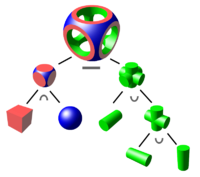
Photo from wikipedia
The Constructive Solid Geometry (CSG) tree, encoding the generative process of an object by a recursive compositional structure of bounded primitives, constitutes an important structural representation of 3D objects. Therefore,… Click to show full abstract
The Constructive Solid Geometry (CSG) tree, encoding the generative process of an object by a recursive compositional structure of bounded primitives, constitutes an important structural representation of 3D objects. Therefore, automatically recovering such a compositional structure from the raw point cloud of an object represents a high‐level reverse engineering problem, finding applications from structure and functionality analysis to creative redesign. We propose an effective method to construct CSG models and trees directly over raw point clouds. Specifically, a large number of hypothetical bounded primitive candidates are first extracted from raw scans, followed by a carefully designed pruning strategy. We then choose to approximate the target CSG model by the combination of a subset of these candidates with corresponding Boolean operations using a binary optimization technique, from which the corresponding CSG tree can be derived. Our method attempts to consider the minimal description length concept in the point cloud analysis setting, where the objective function is designed to minimize the construction error and complexity simultaneously. We demonstrate the effectiveness and robustness of our method with extensive experiments on real scan data with various complexities and styles.
Journal Title: Computer Graphics Forum
Year Published: 2018
Link to full text (if available)
Share on Social Media: Sign Up to like & get
recommendations!